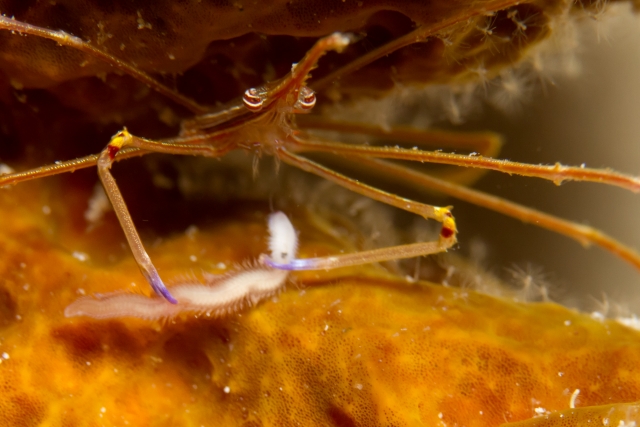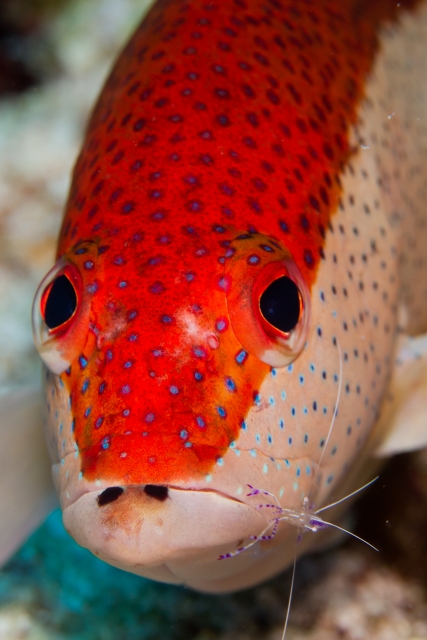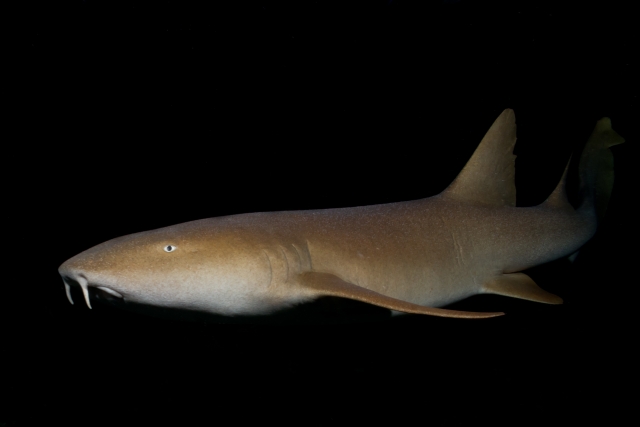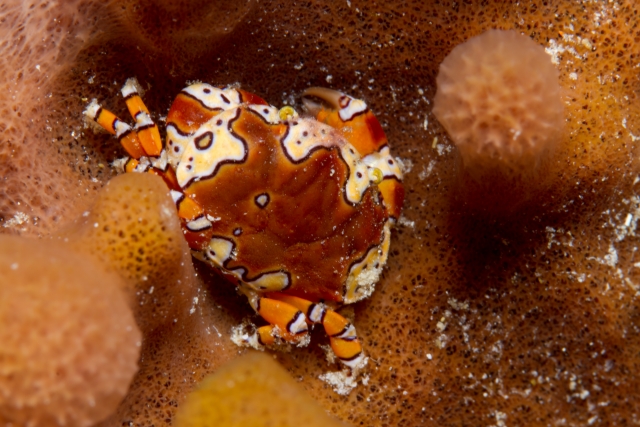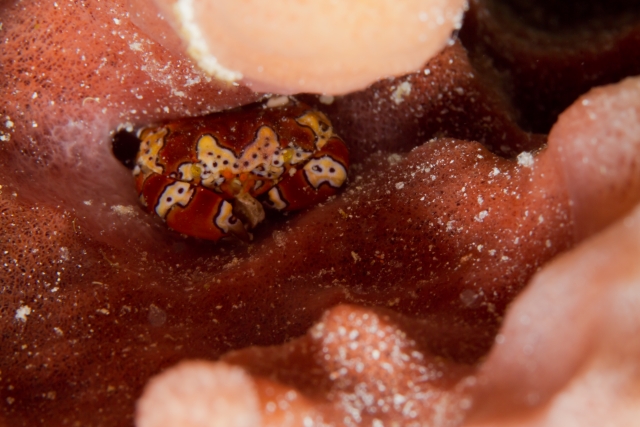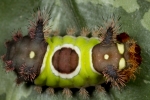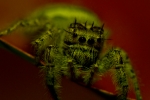underwater
Turks and Caicos Explorer: Arrow Crab Dinner
ktuli — Tue, 11/20/2012 - 19:40
Ok - a few posts ago, I mentioned that I would share a photo of an arrow crab that caught a blood worm just as I was taking photos of it.
The blood worms are harmless worms that swim in the water. Usually they are less than an inch long, though we did see some that were several feet long. During night dives, they are attracted to the lights, and honestly can get downright annoying. When you get too many in front of your dive lights, there are a couple things you can do. First, you can just turn off your dive light and they'll disperse - if a friend is nearby, they'll all swarm to their light while you swim away laughing. Second, you can feed them to brain corals... simply move your light close to a brain coral and the blood worms haplessly swim into the coral and are trapped and eaten. Or, if you're really lucky, you can feed other reef critters...
Technical Data: Canon EOS 7D, Canon EF 100mm f/2.8L Macro IS USM, 1/120th sec at f/8. Image Stabilization on. ISO 640. Ikelite Housing and Port with dual Ikelite 161 Strobes in TTL Mode. Raw conversion and cropped in Photoshop CS5. (mouseover for original uncropped version).
I seem to have taken a break from processing photos. I have seven dives left to process, so hopefully with the added time off from the holiday, I can possible get through the rest of them and get on a more regular posting schedule.
Stay tuned.
- Bill
Turks and Caicos Explorer: More Reef Dentistry
ktuli — Wed, 11/14/2012 - 20:59
Sorry - been a little lax with posting, so I'll try and get back to sharing photos from the trip more regularly. I still have about seven more dives to process the photos from.
Last year, I shared a shot of a Pederson's Cleaner Shrimp on a Spotted Moray Eel. Well, this year, I caught one on a Coney.
Technical Data: Canon EOS 7D, Canon EF 100mm f/2.8L Macro IS USM, 1/200th sec at f/11. Image Stabilization on. ISO 160. Ikelite Housing and Port with Ikelite 161 Strobe in TTL Mode. Raw conversion and cropped in Photoshop CS5.
- Bill
Turks and Caicos Explorer: New Wallpaper
ktuli — Tue, 11/06/2012 - 20:16
Ok just a quick post today to share what has become my new wallpaper on one of my work monitors...
Technical Data: Canon EOS 7D, Canon EF-S 18-55mm f/3.5-5.6 II at 18mm. 1/120 sec at f/22. ISO 320. Ikelite Housing and Port with dual Ikelite 161 Strobes in eTTL mode. Raw conversion and cropped in Adobe Camera Raw (mouseover for original).
Thanks for stopping by.
- Bill
PS: If you haven't voted on the other nurse shark photo or seen the videos, keep scrolling!
Poll: Turks and Caicos Explorer: Nurse Shark Cropping
ktuli — Mon, 11/05/2012 - 19:18
I absolutely love this photo - and the best part about it... it works in so many different ways.
Check out the different crops below and then vote on which one you like best.
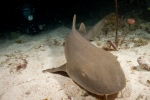 2x3 Horizontal Original |
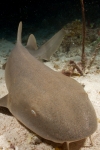 2x3 Vertical Crop |
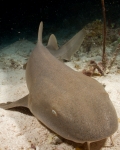 4x5 Vertical Crop |
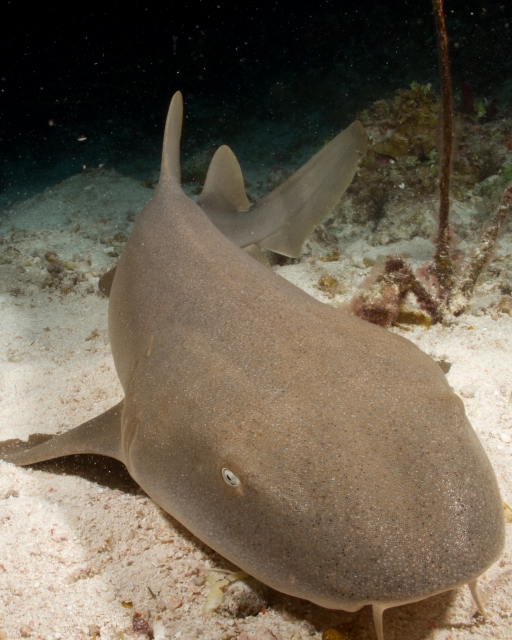 |
||
Technical Data: Technical Data: Canon EOS 7D, Canon EF-S 18-55mm f/3.5-5.6 II at 18mm. 1/120 sec at f/22. ISO 320. Ikelite Housing and Port with dual Ikelite 161 Strobes in eTTL mode. Raw conversion and cropped in Adobe Camera Raw.
In the original framing, I love how you can see one of our dive friends - Jim - in the background also taking photos of the sharks. In particular, I love how wide Jim's eyes look through his mask. With the 2x3 vertical crop, I felt that since the shark's face is so close to the front of the frame, I would crop in tight and let it almost fill the frame - the one downside to that is that its pectoral fin gets cropped out in the process. Which is why I changed ratios and went with the 4x5 crop.
In the end, I really love every version of this photo... Vote below and let me know which one you like best.
- Bill
Turks and Caicos Explorer: Petting the Nurse Sharks
ktuli — Sun, 11/04/2012 - 19:46
Ok - let me preface today's post with a warning... Don't this this on your own. Sharks are definitely still wild animals, and while nurse sharks seem docile, they are responsible for many diver accidents every year - mainly because dives pester them and do not respect their space. These nurse sharks had been swimming near us for several days, and we were able to observe their behavior and had several members of our group who have experience working with the sharks. We let the sharks come and go as they pleased and never prevented them from doing what they wanted to do. We just gave them light scratches and petting, never grabbing a hold of the shark or touching near their face/mouth. Again - do not try this on your own.
This was a pretty awesome experience. These sharks were fairly small - in the range of 3 - 4 feet. Though we did have larger ones swimming in, they didn't really have any interest in being petted - they were hunting.
The little one really liked my camera and kept swimming closer and closer, I got a couple shots of her so close that her face in underneath the lens! But I did get one shot that I absolutely love and I'll share that tomorrow.
- Bill
Turks and Caicos Explorer: Fluorescing Corals (part 2)
ktuli — Thu, 11/01/2012 - 20:16
OK - this stuff is too cool, so here's another blast of fluorescing coral photos (today we're doing all vertically oriented photos).
One extra cool thing to note in this batch... the top photos on either side show a closed coral and the same coral with its feeding polyp tentacles opened. Pretty awesome, no?
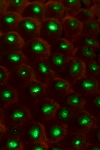 |
 |
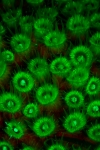 |
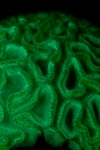 |
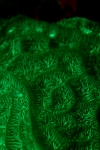 |
|
 |
 |
|
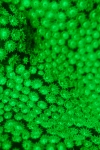 |
 |
Technical Data: Canon EOS 7D, Canon EF 100mm f/2.8L Macro IS USM with Yellow 12 Filter, 1/120th sec at f/8. Image Stabilization on. ISO 640. Ikelite Housing and Port with dual Ikelite 161 Strobes in TTL Mode both with NightSea BE3 Excitation Filters. Raw conversion in Photoshop CS5.
The second photo on both sides appear to be two different types of brain coral. One of the fun things we like to do during night dives is feed blood worms to the brain corals - I don't have any photos of that, but I do have a shot of an arrow crab catching a blood worm that I will share soon!
Stay tuned!
- Bill
Turks and Caicos Explorer: Fluorescing Corals (part 1)
ktuli — Wed, 10/31/2012 - 18:49
What up, fishes!?!
One of the things that I wanted to do on this dive trip was to check out the fluorescence on the reefs. You may have seen some of my land-based results with jumping spiders, but I still was blown away by the results I got.
The equipment I bought was made by NightSea and includes an excitation filter that goes on your light source (flash/strobe) and a yellow lens filter that acts to eliminate the color of the excited light. Basically, the excitation filters produce a bluish light that is the correct wavelength to induce the most common fluorescence responses - the yellow filter then removes that bluish light and returns things back to normal. We also had a special flashlight that had the blue excitation light, plus some yellow filters that went over the front of our masks so we could see the fluorescence effect that way too.
The results were stunning...
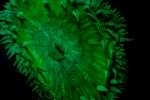 |
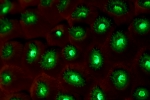 |
 |
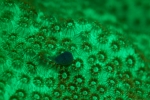 |
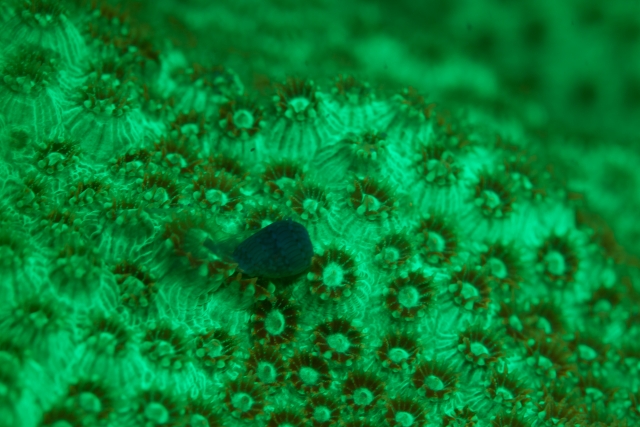 |
|||
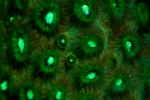 |
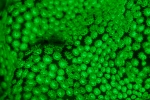 |
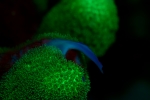 |
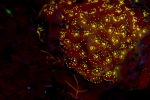 |
Not everything fluoresced on the reefs, so as we shined our lights along the corals, some would glow incredibly bright while others were just black and did nothing. I searched around for small critters like crabs and shrimp, but considering there were always hungry sharks or large horse-eyed jacks feeding during out night dives, it wasn't always the easiest thing to be looking for little stuff while not being able to see anything that wasn't fluorescing.
Maybe next time (and hopefully next time is soon!).
- Bill
Turks and Caicos Explorer: Caribbean Reef Sharks (part 1)
ktuli — Mon, 10/29/2012 - 20:10
Ok - as I hinted at yesterday, I really struggled early in the week.
One of my mistakes was a classic bit of photographer hubris in that I thought I knew enough that adding a new piece of gear to my setup wouldn't be an issue and I'd just pick it up like a fish to water (sorry - terrible pun, I know!). Well, adding a second strobe to my setup certainly was not something I could do without first needing to learn some things - I should have tried out some dry photography with it in the housing and both strobes mounted before going on the trip.
The second issue I had was that there was quite a bit of rust build up. It had been a year since I'd done underwater photography (far too long!), and it took me a while to reacquaint myself with the setup and to remember what settings worked and which didn't. Again, some dry photography might have helped a little, but also just looking at old photos and seeing what worked and what settings were used would have gone a long way.
And the last issue was that despite knowing better, I was using the camera in a way that it just wasn't meant to operated. In particular, with the 100mm macro lens mounted, I certainly could focus on larger subjects that were a ways off, but I really shouldn't have been doing so. I know to reduce the water between me and my subject, and I know the ugly results I get when I fail to do so.
Despite that, and with a liberal amount of Photoshop work, here is my first set of Caribbean Reef Shark (Carcharhinus perezii) from the trip. Hopefully I have better ones to share later...
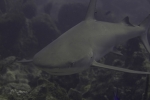 |
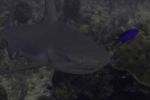 |
 |
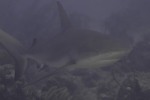 |
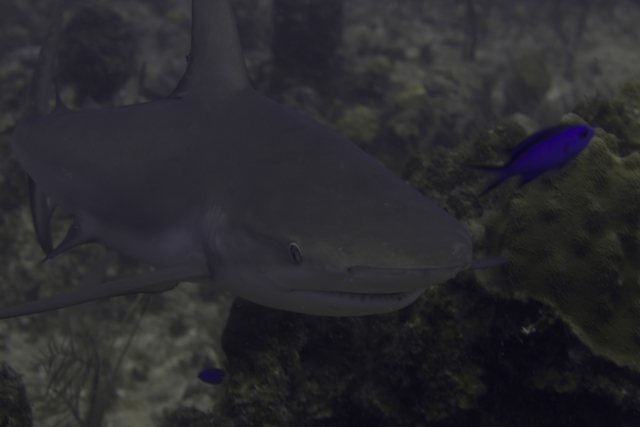 |
|||
Technical Data: Canon EOS 7D, Canon EF 100mm f/2.8L Macro IS USM, 1/200th sec at f/8. Image Stabilization on. ISO 320. Ikelite Housing and Port with dual Ikelite 161 Strobes in TTL Mode. Raw conversion in Photoshop CS5, Color cast removed in Photoshop Elements 9.
I kept these not only because I was able to partially salvage them, but also because I felt these were the first dives we were on where we saw "real" sharks. I know the nurse sharks we've seen before are quite real (and potentially dangerous in the wrong situation - ie: diver stupidity), but these are the first sharks with that classic shark body shape, and they weren't tiny little things... the ones we saw all week ranged in size from 6-10 feet long, and were bulky in weight to match... and fast. Just watching them swim was a treat - being in the water with such a beautiful creature and not being afraid (ok - mostly not afraid) of it was completely incredible.
- Bill
Turks and Caicos Explorer: Gaudy Clown Crab
ktuli — Sun, 10/28/2012 - 20:06
I normally don't like to do this when processing photos, but I've decided to bounce around and pick and choose the order I process the photos from our last dive trip. One reason for this is that I was really struggling early in the week (more on that later), and so to get to the better photos, I have to jump ahead.
Another reason is that I am much more excited to share some of the subjects later in the week. Today's subject is just that.
This is a Gaudy Clown Crab (Platypodiella spectabilis). According to my ID book, these are listed as "occasional", but this is the first one I have ever seen, and when the captain of our boat asked me if I could find it again because he had never managed to get a good photo of one before (not sure if he'd seen one before or not), I felt really pleased with myself for having found it. Keep in mind, they only get to a maximum of 3/4 inch in size...
Technical Data: Canon EOS 7D, Canon EF 100mm f/2.8L Macro IS USM, 1/120th sec at f/16. Image Stabilization on. ISO 100. Ikelite Housing and Port with Ikelite 161 Strobe in TTL Mode. Raw conversion in Photoshop CS5.
So while I felt finding one of these crabs was an accomplishment, I took the challenge to find another on the following dive. I spent the entire dive searching barrel sponge after barrel sponge. And while I'm not 100% sure if this is the same crab or second one (I've tried matching the patterns, and can't come to a decision on it), I am very impressed that I was able to locate one of these crabs for the captain. Unfortunately, as you can see - it wasn't in as good of a location to photograph, so he'll likely have to keep looking... :(
Technical Data: Canon EOS 7D, Canon EF 100mm f/2.8L Macro IS USM, 1/120th sec at f/16. Image Stabilization on. ISO 100. Ikelite Housing and Port with Ikelite 161 Strobe in TTL Mode. Raw conversion in Photoshop CS5.
This is why I love diving... finding these beautiful little creatures that most people have never seen before.... and then doing it again.
- Bill
Turks and Caicos Explorer: Swim with Abby
ktuli — Wed, 10/24/2012 - 18:57
What up, fishes?
Ok! We're home from yet another fantastic scuba trip. This was quite the trip - lots of sharks, coral fluorescence, macro and wide-angle photography, our 100th dives, and.... video!
Technical Data: Canon EOS 7D, Canon EF-S 18-55mm f/3.5-5.6 II. Ikelite Housing and Port with dual Ikelite 161 Strobes in Video Light mode.
It is going to take me a little while to get through all the photos, so I figured I'd share a video to start things off. This friendly little (about 4 foot) nurse shark is lovingly named Abigale or Abby by the crew of our boat - the Turks and Caicos Explorer II. She visited us on many dives towards the end of the week while we were in French Cay, so I took this opportunity to follow her for a short swim.
Stay tuned as I have tons of photos and more videos to share!
- Bill

